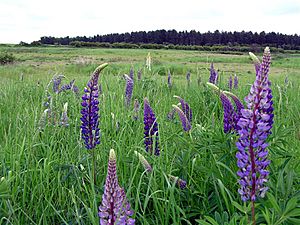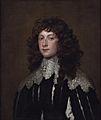Battle of Gainsborough facts for kids
Quick facts for kids Battle of Gainsborough |
|||||||
|---|---|---|---|---|---|---|---|
| Part of the First English Civil War | |||||||
 |
|||||||
|
|||||||
| Belligerents | |||||||
| Commanders and leaders | |||||||
| Charles Cavendish † | Sir John Meldrum Colonel Oliver Cromwell |
||||||
| Strength | |||||||
| 1,200 | |||||||
The Battle of Gainsborough was an important fight during the First English Civil War. It happened on 28 July 1643. The town of Gainsborough, Lincolnshire was very important because of its location. It was a base for the Royalists, who supported King Charles I. They used it to bother the Parliamentarians, who were stronger in the area of Lincolnshire.
In July 1643, Parliamentarian forces captured Gainsborough. The Royalists, led by Charles Cavendish, tried to take it back. However, their attempt failed in a battle where Colonel Oliver Cromwell showed great skill as a cavalry leader.
Why Gainsborough Was Important
When the English Civil War began, Gainsborough was in an area that mostly supported Parliament. But the town itself had strong feelings for the Royalists.
A Key Location
Gainsborough was very important to both sides. It was located on a crossing of the River Trent. Also, major roads leading north and south passed through it. This made it a valuable place to control.
Royalists Take Control
In March 1643, a Royalist group from Newark captured Gainsborough for King Charles. The town quickly gave up without a fight. The Earl of Kingston was put in charge of the town.
Royalist forces used Gainsborough to attack Parliamentarian areas in Lincolnshire. They attacked places like Louth and Market Rasen. They also captured gunpowder meant for Rotherham. These actions made Parliament decide to act.
Parliament Strikes Back
Lord Willoughby of Parham led a surprise night attack on Gainsborough. On 16 July 1643, he captured the town. The Earl of Kingston was captured and later died.
However, Lord Willoughby's victory might not last long. The Royalists immediately sent Charles Cavendish with his soldiers to take Gainsborough back.
Parliamentarian Reinforcements
The Parliamentarians sent help to Gainsborough. Sir John Meldrum led forces from Nottingham. Colonel Oliver Cromwell brought soldiers from Cambridgeshire. These two groups met on 27 July at North Scarle. A group from Lincoln also joined them.
The Battle of Gainsborough
The next day, 28 July 1643, the Parliamentarian army marched north. There were about 1,200 soldiers.
Meeting the Royalists
Near the village of Lea, just south of Gainsborough, they met a small group of Royalist horsemen. These 100 riders were the advance guard of Cavendish's army. After a short fight, the Royalists were pushed back. They retreated to Cavendish's main group of horsemen. This main group was waiting on top of Foxby Hill, east of Gainsborough.
Fighting on Foxby Hill
The Parliamentarian troops kept moving forward. They advanced up Foxby Hill. There, they came face-to-face with Cavendish's main force. The fighting was intense for a while. Then, the Royalists began to fall back. They eventually ran away from the battlefield. The Parliamentarian cavalry chased after them.
Cromwell's Clever Move
During the chase, Cromwell noticed something important. Cavendish had kept a group of horsemen hidden as a reserve. This reserve was now moving to attack the Parliamentarians who had stayed on the field.
Seeing this, Cromwell, Major Whalley, and three groups of Parliamentarian horsemen attacked Cavendish's reserve from behind. Cromwell and his soldiers forced Cavendish's horsemen down the hill. They pushed them into the flat, marshy land near the River Trent. About 300 Royalists were killed there. Cavendish was knocked off his horse and killed by a sword. The place where he died later became known as "Candish Bog."
After the Battle
After the battle, Cromwell rode into Gainsborough. He brought supplies for Lord Willoughby's soldiers. While this was happening, news arrived. A small Royalist force was marching towards Gainsborough from the north.
Facing a New Threat
Cromwell and Meldrum thought this was just a small group of Cavendish's soldiers. They rode out to meet them with 600 of Willoughby's foot soldiers. At Morton, they drove off two groups of Royalist horsemen.
Then, they climbed a hill and were shocked. They saw the huge army of Lord Newcastle. This army had about 30 regiments of foot soldiers and many horsemen. They were marching on Gainsborough to take it back for the King.
A Strategic Retreat
Willoughby's foot soldiers became disorganized and fell back. Cromwell's own men and horses were tired from the recent battle. So, Cromwell ordered a retreat. They performed a very disciplined move. Two groups of horsemen stayed behind to protect the main force. One group was from Cromwell's regiment, and the other was from Lincoln. They took turns holding back the Royalists. This allowed the main force to reach the safety of Lincoln. They lost only two men during this retreat.
Gainsborough Falls Again
Meanwhile, Newcastle's army surrounded Gainsborough. They fired cannons at the town. After a three-day siege, Lord Willoughby surrendered on 31 July. Newcastle then turned his army around and headed north to attack Hull. He left a Royalist group of soldiers in Gainsborough. With the town back in Royalist hands, their raiding parties once again started to bother Parliamentarian areas.
Images for kids





